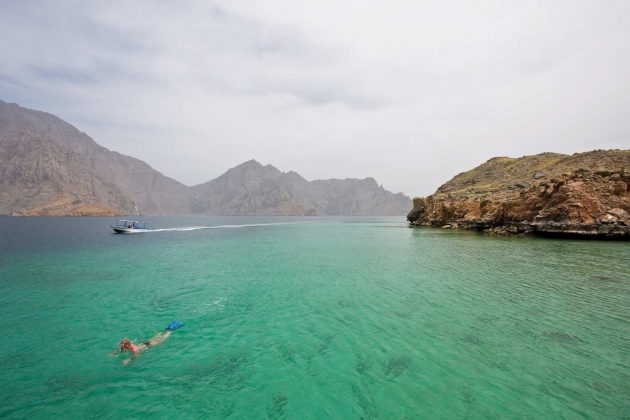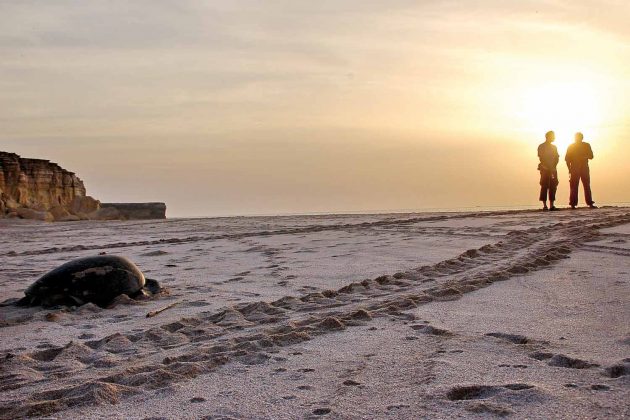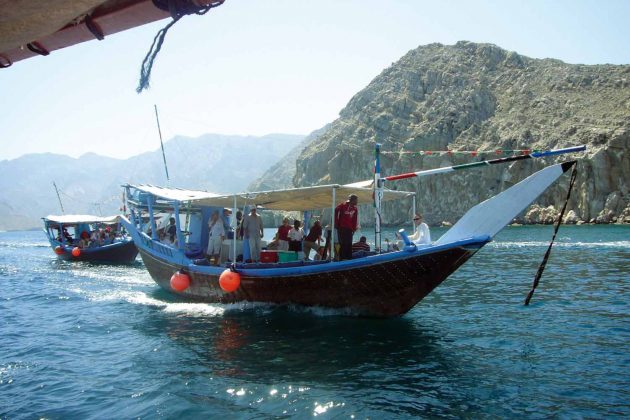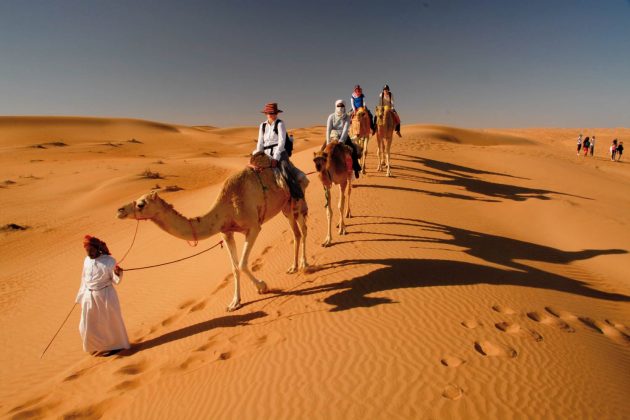Diving in the Arabian Fjords
Laying claim to over 3,000 kilometres of rugged coastline, the Sultanate of Oman hugs the Arabian Peninsula with all its might. And one of the country’s most spectacular natural wonders can be found in the Musandam Peninsula up north. An area separated from the rest of Oman by the United Arab Emirates, the peninsula’s mighty fjords are the reason why the area is often referred to as the ‘Norway of Arabia’. With the brightest of lapis-hued waters meeting the dramatic limestone cliffs—that in some areas drop 2,000 metres into the ocean—the vista is unparalleled. But the true beauty of the fjords lies beneath the aqua that is teeming with exotic marine life. After a tranquil ride in a traditional Omani wooden boat called a dhow to Telegraph Island, where it drops anchor, you can deep-sea dive or snorkel for a tryst with the friendliest of dolphins who cheekily follow you with their squeaky clicking providing the soundtrack to your day of bliss.
**Fjord is a long, narrow inlet with steep sides or cliffs, created by glacial erosion
Go cave hopping!
Oman is packed with secrets that are simply waiting to be told. And here is one that will surprise you. Well, the Majlis Al Jinn Cave, located in the village of Fins in the Wilayat Quriyat near the capital Muscat, has the distinction of being the second-largest known cave chamber in the world with a floor area of 58,000 square metres. Besides this natural wonder, you can also visit the Al Hoota caves that can be found at the base of the Jebel Shams Mountain. Home to two lakes, one of which has rare blind fish, these caves are abounding with vertiginous stalactites and stalagmites that will stun you silent with their eerie beauty. Lying 40 kilometres from the southern Omani city of Salalah, the limestone cave of Al Marnif overlooks a mighty blowhole from where the waters of the Arabian Sea gush forth. Equally spectacular is the Teeq Cave in Dhofar. This cave has six entrances, with the western entrance being particularly impressive from where you can see the ‘Well of Birds’ or Tawi Ateer Sinkhole in all its rugged charm.
Waddle with turtles at Ras Al Jinz
Giant green turtles and the Middle East? There couldn’t be two more incongruous images. But it takes a place like Oman to harmoniously put the two together—providing you with a true vacation with a difference! Around 65 kilometres east of the city of Sur, the wide stretch of white sanded beach extending from Ras Al Hadd to Masirah Island in Oman’s Al Sharqiyah South Governorate sees a spellbinding sight unfold every year. Here, thousands of green turtles return to lay their eggs on the same beach where they were born decades ago. And around 50 – 70 days later, the tiny hatchlings set off for their perilous journey into the blue. This phenomenon can be witnessed from the Ras Al Hadd Turtle Reserve on Ras Al Jinz Beach that provides a quiet sanctuary for the entire process, thus securing the continued survival of the species and protecting them from extinction.
Hike up a limestone mountain and go fossil spotting
Jebel Harim, which literally means ‘Mountain of Women’ at 2,087 metres above sea level is the highest peak in Musandam. This is THE place to satisfy all your ‘Cliffhanger’ fantasies as you scale its razor-sharp slopes in search of fossils. Yes, you heard right, fossils! Once a sub-oceanic mountain, Jebel Harim has plenty of rocks and boulders where you can easily see some superbly preserved fossils, affording you the chance of playing discoverer as you make sense of how ancient submarine creatures like mollusc, fish, clams and numerous trilobites lay plastered across their surface. Offering another great facet to the mountain are the fine collection of petroglyphs depicting ancient agrarian and cattle herding scenes of daily life that were carved into the mountaintop boulders thousands of years ago, but that are just as vivid and striking today. Don’t miss out on a visit to the many cave dwellings that lay scattered along the mountain’s slopes that come complete with bedrooms and kitchens used by people as homes right up until the 1940s.
Dune-bashing and sand-skiing in the Wahiba Sands
We couldn’t resist sneaking in this little Middle Eastern adventure sport cliché. But the way it is done in Oman is truly different. The undulating desert area of Wahiba Sands, two hours out of Muscat, is perfect for a bit of sandy action. Here you can go on a 4WD dune-bashing safari or have a go at quad-biking or better still try your hand [or perhaps we should say feet!] at the newest desert sport to take Oman by storm, sand-skiing. But if you prefer a more relaxed, leisurely desert tryst, then a camel ride that takes you to a bedouin village tucked away in the middle of the desert is a great way to get a glimpse into the nomadic lifestyle of the desert tribes. On the way back to Muscat, take a detour to the Wadi Bani Khalid oasis. This water body surrounded by swaying date palm trees is perfect to try your hand at diving from the short cliffs into the bluest of waters you will ever see. A picnic on the shores is what most local Omanis enjoy when at Wadi Bani Khalid and so should you, once you’re done with your aqueous adventures in the cool waters.
Getting there
There are a number of daily direct flights to Muscat from all major Indian cities on airlines like Oman Air, Air India and Jet Airways. Visas need to be taken in advance at the Oman Consulate in India which take three to four working days to process. Travel within Oman is easy with many flights, buses and ferries plying between its various cities and towns. It is also possible to hire a vehicle for a self-drive vacation. But do note that in Oman vehicles drive on the right side of the road.
When to visit
The months from October to April are the best time to visit Oman which experiences a pleasant climate, while May to September are the hot and humid months.
Accommodation
There is a good range of accommodation options available in Oman that suit most budgets. The average cost for accommodation is around 50 Omani Rials per night for two.
What to buy
- Traditional decorated silver daggers called khanjars
- Tubs of saffron-rich Omani halwa
- Dates, especially the juicy khallas variety
- Hand-blown multi-coloured glass lamps.
This was first published in the November 2013 issue of Complete Wellbeing.








